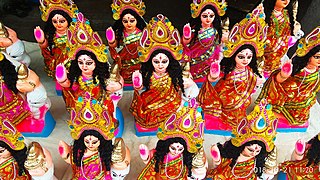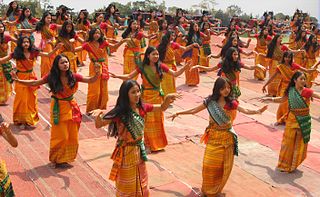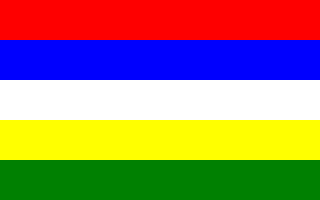
Bihu is of three types and it is an important cultural festival unique to the Indian state of Assam – 'Rongali' or 'Bohag Bihu' observed in April, 'Kongali' or 'Kati Bihu' observed in October or November, and 'Bhogali' or 'Magh Bihu' observed in January. The festivals present an admixture of Tibeto-Barman, Austroasiatic and Indo-Aryan traditions entwined so intricately that it is impossible to separate them—festivals which are uniquely Assamese to which all communities of Assam had contributed elements. The Rongali Bihu is the most important of the three, celebrating spring festival. The Bhogali Bihu or the Magh Bihu is a harvest festival, with community feasts. The Kongali Bihu or the Kati Bihu is the sombre, thrifty one reflecting a season of short supplies and is an animistic festival.

Saraswati, also spelled as Sarasvati, is the Hindu goddess of knowledge, music, flowing water, abundance and wealth, art, speech, wisdom, and learning. She is one of the Tridevi, along with the goddesses Lakshmi and Parvati. She is a pan-Indian deity, also revered in Jainism and Buddhism.

Vijayadashami, also known as Dussehra, Dasara or Dashain, is a major Hindu festival celebrated every year at the end of Durga Puja and Navaratri. It is observed on the tenth day of the month of Ashvin, the seventh in the Hindu lunisolar calendar. The festival typically falls in the Gregorian calendar months of September and October.

Boro, also called Bodo, is an ethnolinguistic group native to the state of Assam in India. They are a part of the greater Bodo-Kachari family of ethnolinguistic groups and are spread across northeastern India. They are concentrated mainly in the Bodoland Territorial Region of Assam, though Boros inhabit all other districts of Assam and Meghalaya.

Durga Puja, also known as Durgotsava or Sharodotsav, is an annual festival originating in the Indian subcontinent which reveres and pays homage to the Hindu goddess Durga, and is also celebrated because of Durga's victory over Mahishasura. It is celebrated all over the world by the Hindu community, but it is particularly popular and traditionally celebrated in the Indian state of West Bengal, and other states like Bihar, Assam, Tripura, Odisha, Jharkhand, Uttar Pradesh and some other countries like Bangladesh and Nepal. The festival is observed in the Indian calendar in the month of Ashvin, which corresponds to September–October in the Gregorian calendar. Durga Puja is a ten-day festival, of which the last five are of the most significance. The puja is performed in homes and public, the latter featuring a temporary stage and structural decorations. The festival is also marked by scripture recitations, performance arts, revelry, gift-giving, family visits, feasting, and public processions called a melā. Durga Puja is an important festival in the Shaktism tradition of Hinduism. Durga Puja in Kolkata has been inscribed on the intangible cultural heritage list of UNESCO in December 2021.

Chandi or Chandika is a Hindu deity. Chandika is another form of Mahadevi, similar to Durga. Chandika is a powerful form of Mahadevi who manifested to destroy evil. She is also known as Kaushiki, Katyayani, AsthadasabujaMahalakshmi and Mahishasuramardini.

Sharad Purnima is a religious festival celebrated on the full moon day of the Hindu lunar month of Ashvin, marking the end of the monsoon season. The full moon night is celebrated in different ways in various cultural regions across Indian subcontinent.

The Bagurumba is a traditional dance of the indigenous Boro people living in the State of Assam and North East India. It is also called '''butterfly dance''' because it's personification of movements of butterflies and birds. In this occasion, only the Bodo women perform the dance, wearing their colourful traditional attire dokhna, jwmgra (fasra) and aronai. The dance is accompanied by handmade percussion instruments such as 'kham', sifung, jota, serja, and gongwna, tharkha.

Bathow Puja is an important religious festival of the Bodo-Kacharies of Assam, India. In this festival, the people worship a god known by different names like Gila Damra, Khuria Bwrai, Sri Brai, Bathow Bwrai etc. The different forms of this festival are-Garja, Kherai and Marai. Among these festivals Kherai is the most significant.

Boro culture is the culture of the Boro people in Assam. For long, the Boros have been farmers living in an Agrarian society with a strong tradition of fishery, poultry, piggery, with rice and jute cultivation, and betel nut plantation. They make their own clothing from scratch, such as traditional attires. In recent decades, the Boros are influenced by recent social reforms under Boro Brahma Dharma and the spread of Christianity.

Devī is the Sanskrit word for 'goddess'; the masculine form is deva. Devi and deva mean 'heavenly, divine, anything of excellence', and are also gender-specific terms for a deity in Hinduism.

Navaratri is an annual Hindu festival observed in honor of the goddess Durga, an aspect of Adi Parashakti, the supreme goddess. It spans over nine nights, first in the month of Chaitra, and again in the month of Ashvin (September–October). It is observed for different reasons and celebrated differently in various parts of the Hindu Indian cultural sphere. Theoretically, there are four seasonal Navaratri. However, in practice, it is the post-monsoon autumn festival called Sharada Navaratri. There are 2 Gupta Navaratris as well, one starting on the Shukla paksha Pratipada of the Magha Month and another starting in the Shukla Paksha Pratipada of Jyestha Month.

Kali Puja, also known as Shyama Puja or Mahanisha Puja, is a festival originating from the Indian subcontinent, dedicated to the Hindu goddess Kali. It is celebrated on the new moon day of the Hindu calendar month of Ashwayuja or Kartika. The festival is especially popular in the region of West Bengal, and other places like Mithila and Anga of Bihar, Jharkhand, Odisha, Assam, and Tripura, as well as the town of Titwala in Maharashtra, along with the neighbouring country of Bangladesh.

Bwisagu is one of the most popular seasonal festivals of the Bodos of Assam. The Bodos call this popular festival "Bwisagu", which means the start of the new year. Bwisagu is a Boro word which originated from the word "Bwisa" that means "year" or "age" and "Agu" that means "starting" or "start" [1]. This Bwisagu festival is observed at the beginning of the first month of the Boro year, around mid-April.

Bathouism is the folk religion of the Boro people of Assam in Northeast India. The name Bathou in Boro means five principles. The five principles are: bar (air), orr (fire), ha (earth), dwi (water) and okhrang (ether). The chief deity, called Bathoubwrai — omnipresent, omniscient and omnipotent— is said to have created the five principles. Though there are other minor gods and goddesses, Bathoubwrai is considered the Supreme God. Bathoubwrai is unseen. The second most important deity is Mainao, the daughter of Bathoubwrai, who is considered as the "protector of the rice fields".
Here is a list of glossary of Culture of India in alphabetical order:

Datta Jayanti, also known as Dattatreya Jayanti, is a Hindu festival, commemorating the birth of the Hindu deity Dattatreya (Datta), a combined form of the Hindu male divine trinity of Brahma, Vishnu, and Shiva.
Deodhani dance is a Shaman folk dance from the Indian state of Assam. It can be performed either solo or in a group. Deodhani is of Bodo origin. A group performance of Deodhani generally consists of three or four women. The dance form is associated with the worship of the snake goddess Marei/Maroi. A Deodhani dance is generally performed to the accompaniment of songs sung by an Ojha, a Bodo traditional chorus leader in the Darrang district of Assam.

Karam is a harvest festival celebrated in Indian states of Jharkhand, West Bengal, Bihar, Madhya Pradesh, Chhattisgarh, Assam, Odisha and Bangladesh. It is dedicated to the worship of Karam-Devta (Karam-Lord/God), the god of power, youth and youthfulness. It celebrated for good harvest and health.
The Hajong ethnic religion, also called Dyaoism, is the ethnic religion of the Hajong people of Northeast India, the fourth largest ethnicity in the Indian state of Meghalaya. The practice is a mixture of Hinduism and the animistic beliefs of the Hajong people. This sect of Hinduism includes worship of gods and deities of Hindu origin, demigods and spirits, all referred to as Dyao.
















